Associate Professor Kawakami and the team are currently aboard the R/V Mirai, conducting research. Updates from the expedition will be posted as they become available.
Final Issue Mirai Arctic Expedition Completed
The R/V Mirai finally returned to Shimizu Port on October 6 after completing its observations in the Arctic Ocean. For a while after disembarking, I still felt as if I were swaying at sea, but the sensation has now completely disappeared.
Thanks to the cooperation of the captain and crew, the technical staff, and the researchers on board, we were able to obtain valuable data and samples from this cruise. We will analyze these to clarify the current status of the Arctic environment and how it may change in the future. Please look forward to our progress and contributions to Arctic research.
The Mirai, which has supported Arctic Ocean research for about 28 years, is scheduled to retire this year. This cruise was its final Arctic cruise. Future Arctic cruises will be taken over by the new icebreaker “Mirai II.” Because Mirai II is designed to enable observations in areas covered by sea ice, it will allow for more detailed investigations of the environment and ecosystems beneath the ice cover. We are now developing various ideas to expand our knowledge of the Arctic Ocean.

Vol.4 Ice Catch!(Updated: 10/2)
One of the main targets of this year’s Mirai cruise is sea ice. In the Arctic Ocean, sea ice is rapidly decreasing as temperature increases. How does this reduction of sea ice impact the Arctic environment and ecosystem? To understand this, we need to examine the sea ice itself. For this purpose, we conducted sea ice sampling, what we call “Ice Catch”, three times during the cruise.
This year, the extent of sea ice was greater than expected, providing good conditions for sea ice observation and sampling. On the other hand, the presence of sea ice makes ship navigation and observation more dangerous, so we often had to change our observation plan.

For collecting sea ice, a large basket is lowered from the ship using a crane, and sea ice suitable for research purpose (dirty and stink one) is carefully selected and retrieved. Thanks to the skillful work of the crew, we always succeeded to big catch.

Once on board, the collected ice is cut into smaller pieces using saws and chisels. For each piece, we record its shape, measure its internal temperature, and then preserve it in freezing for later analysis.
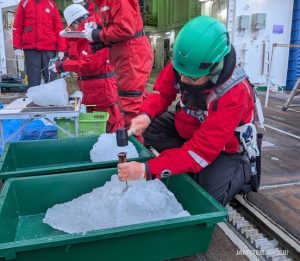


As its name suggests, sea ice is frozen seawater. However, when we directly observe the sea ice in the Arctic, we notice that it differs greatly from the ordinary ice we are familiar with in daily life, like the ice frozen in a refrigerator.
First, sea ice is movable. Sea ice drifts under the influence of winds and currents. For example, the drift ice that covers the coastlines of Okhotsk Sea side of Hokkaido (like Shiretoko and Monbetsu) during winter originates in the northern Okhotsk Sea. Southerly wind and current transport them to Hokkaido. This raises a question: where and when was the sea ice we collected here formed, and what path did it take to reach here?
Second, sea ice is often dirty. As seawater freezes, it incorporates sediments, phytoplankton, and various materials. Because of this, sea ice can transport these substances and eventually release them when it melts along with freshwater. This process strongly influences the biogeochemical cycle and primary production in the Arctic Ocean. This leads to a question: what kinds of materials are contained within sea ice?
Vol.3 Exploring ecological shift of plankton in the Arctic Ocean(Updated: 9/18)
Plankton are organisms that float and drift in the water column. Various taxonomic groups spend their life as a plankton in the ocean, with various body sizes ranging from microscopic phytoplankton to macro-zooplankton, such as jellyfish, having over several meters long. Plankton are an essential part of the marine food web. Phytoplankton perform photosynthesis and create organic matter as primary production of the food web, and zooplankton that prey on them are a primary food for larger organisms like fish. Therefore, it is important to clarify how increasing water temperature and changes in light conditions due to sea ice reduction (it is darker under the ice) in the Arctic Ocean affect the primary production of phytoplankton, and how this eventually changes the ecology of zooplankton.
Ice-edge bloom, which is driven by the freeze-thaw cycle of sea ice, is one of the phenomena we are focusing on. The growth of phytoplankton shows clear seasonality, which is influenced by nutrient and light availability. When these conditions become suitable, a phytoplankton bloom occurs. In the Arctic, summer days are extremely long, while days are extremely short during the winter. Sea ice also adds another layer of seasonal change to the bloom. Ice-covered waters are darker than open-water areas, but as the ice begins to melt, more light becomes available for phytoplankton. Along with this, nutrients and phytoplankton are released from the melting ice, causing a bloom in areas adjacent to the ice edge. Considering the current decline of sea ice, such blooms may be shifting to a typical spring bloom, which usually occurs in ice-free regions.
On the R/V Mirai, zooplankton are collected using a quad NORPAC net with different mesh sizes. The nets are vertically towed from a certain depth to the surface, filtering a certain amount of seawater for capturing zooplankton. These zooplankton are sorted under a dissecting microscope for analysis of fatty acid components and haplotypes. Additionally, an underwater camera is used to directly document the detailed vertical distribution of meso- and macro-zooplankton, which is difficult to collect with net sampling. Combining these observations helps us better understand the relationship between the ocean environment and plankton.
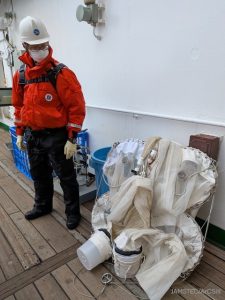
Photo 1: Towing a net is the primary method for plankton research. On the R/V Mirai, we use a combination of conical nets with different mesh sizes to collect various types of plankton.
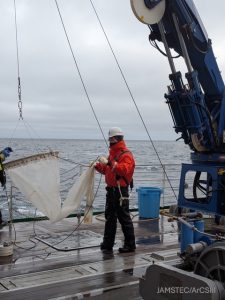
Photo 2: A net was vertically towed and retrieved onboard. The collected plankton are gathered from the cod end, which is the terminal part of the net.

Photo 3: In the laboratory, the collected plankton are examined under a microscope to identify their species and photographed with a digital camera.
Vol.2 Environmental DNA survey in the Arctic cruise(Updated: 9/16)
About 230 fish species are reported in the Arctic Ocean. How do they distribute in the Arctic Ocean? How are their distribution and abundance influenced by recent increases in water temperature and sea ice reduction? How will species interactions change following their distributional shift, and can it eventually trigger the restructure of the entire ecosystem?
The Arctic Ocean is a remote area and hardly accessible with a severe climate such as subzero temperature and sea ice cover in winter. Therefore, it is difficult to capture the rapid changes in the Arctic fish using conventional methods such as net surveys. To overcome this limitation, we are using environmental DNA (eDNA), a new method to investigate the life in the ocean. This method allows us to quickly collect information on fish diversity and distribution.
eDNA is the DNA contained in the environmental sample such as seawater, soil, or even air. This novel technique is emergingly used to study the presence of macro-organisms like fish, mammals, and invertebrates. Unlike microbial DNA in the environment, presence of eDNA can indirectly indicate the presence of its source organism. This technique is relatively new but is advancing rapidly. Its usefulness has been demonstrated for a wide variety of organisms in various environments, including, of course, the Arctic Ocean.
The most common way to collect eDNA from seawater is filtration. On this cruise, I am filtering seawater continually. The seawater samples are collected from various depths from the surface to near the seafloor across continental shelf and basins. To collect water from deeper depths, we use water samplers mounted on CTD. The collected eDNA samples will be analyzed to study the distribution of cods such as polar cod, and the fish community structure associating with various environmental factors.


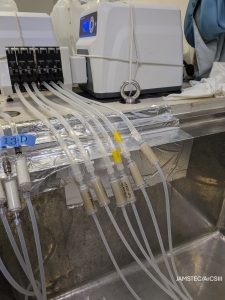
Vol.1 We are in the Arctic Ocean(Updated: 9/16)
Hello from the Arctic, I’m Tatsuya Kawakami, a specially appointed associate professor in the Uehiro Laboratory for Oceanography. Three faculty members (Dr. Matsuno, Dr. Nomura, and I) from our laboratory are currently on an Arctic cruise conducted by JAMSTEC’s R/V Mirai.
We are currently on the Chukchi Sea. The location is approximately 72°N, 151°34’W. Air temperature is almost around 0°C and a water temperature is about 2°C. During our observations, we have seen snow, encountered a polar bear swimming along the ship, and even saw the Northern Lights on a clear night. We are now approaching the sea ice zone. The summer in the Arctic is quite different from that in Japan.
Our purpose for this cruise are: to clarify the diversity and distribution of fish in the Arctic Ocean (Kawakami), to understand changes in primary production and their impact on zooplankton (Matsuno), and to comprehend how increased freshwater inflow (e.g., melting sea ice and river water) affects carbon dioxide dynamics in the Arctic Ocean. In the “era of global boiling,” the Arctic is experiencing a rapid increase in water temperature and drastic decrease in the sea ice that characterize the Arctic environment. We hope that our research will contribute to understand how the Arctic environment and ecosystem respond to the global warming.
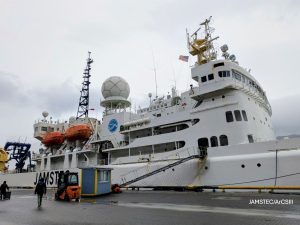
Photo: The R/V Mirai in Dutch Harbor, located on Unalaska Island in the Aleutian Islands. While Dutch Harbor is a small town, it is well known as a fishing port.
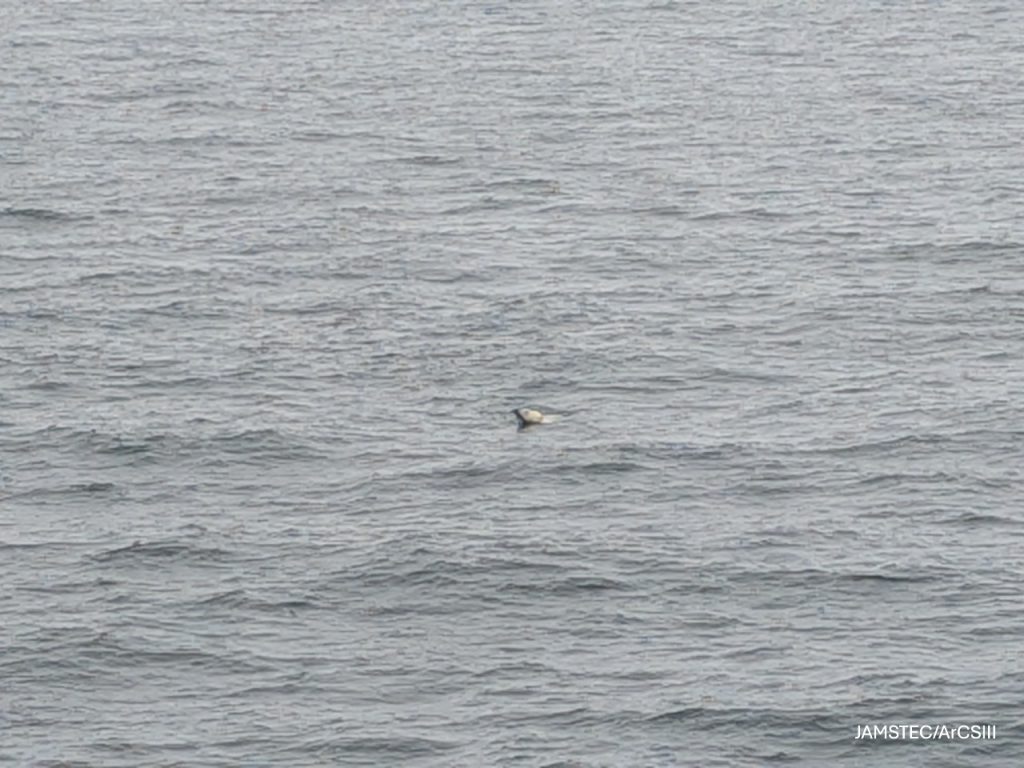

©Copyright ulo.fish.houdai.ac.jp All Right Reserved.